Optimal Control Strategy for Distributed Energy Resources in a DC Microgrid for Energy Cost Reduction and Voltage Regulation
Abstract
1. Introduction
2. The EMS for a DC Microgrid
2.1. Configuration of the DC Microgrid
2.2. The Objective of DER Control in a DC Microgrid
- The MG-EMS was designed to minimize the total operating cost of the microgrid in terms of the load consumption and the EV charging cost. The MG-EMS tries to charge the EV during a high PV generation period or a low electricity tariff period. During peak-loading conditions, the MG-EMS encourages the EVs to discharge their battery to enable shifting of the peak load.
- The EMS for the DC microgrid controls the DERs to maintain the voltage profiles on the distribution lines within the normal range. Because of the low voltage level, the voltage profiles in the DC distribution system are very sensitive to variations in the load consumption and DER generation. Small changes in the loads and PV plants can easily make the voltage profiles on the distribution system drop or rise out of the normal range, which is defined as within ±5% of the rated voltage. Therefore, voltage control is one of the most interesting issues in DC microgrid operations.
- The MG-EMS can curtail DERs such as PV plants for overvoltage regulation in some critical cases.
- Two continuous variables representing the EV charging and discharging rates of the connected EV. Based on these, the MG-EMS can assign EV charging or discharging to minimize the operating cost of the DC microgrid and maintain the voltage profiles in the distribution lines.
- PV output-power curtailment. The EMS for the DC microgrid can curtail the PV power via the power electronic controller to reduce the overvoltage problem when the plugged-in EV batteries cannot solve it.
- Load shedding/shifting. The MG-EMS can shift or shed loads if the discharging of connected EV batteries cannot solve the undervoltage problem.
3. Formulation of Objective Function for DER Control
3.1. Statement of the Problem
3.2. Definition of Objective Function
3.3. Equality and Inequality Constraints for Optimization
3.3.1. Voltage Regulation Constraints
- Off-diagonal elements:
- Diagonal elements:where N is the number of buses; and are the bus voltages at the k-th and i-th nodes, respectively; and G denotes the conductance matrix. The conductance matrix is similar to the bus admittance matrix for an AC distribution system, with the only difference being the absence of the reactance components.
3.3.2. EV Charging/Discharging Restriction Constraints
- Normal operation mode ( and ). When there are no voltage problems, the EVs can be in idle mode or charging/discharging mode to minimize the total operational cost of the DC microgrid. To avoid violating the constrained maximum charging and discharging power and preventing the simultaneous charging and discharging of the connected EVs during the scheduling process, the following constraints are implemented:where is a binary variable that represents the charging and discharging status of the connected EVs at the time step j defined as:
- Undervoltage operation mode (). The EVs are restricted to either idle mode or discharging mode to avoid the worst undervoltage problems. The following constraints are implemented:
- Overvoltage operation mode (). The EVs are restricted to either idle mode or charging mode to avoid the worst overvoltage problems. The following constraints are implemented:
3.3.3. SoC of the EV’s Batteries
4. Optimal DER Control Scheme
4.1. Optimization with a 24-H Sliding Window
4.2. The Proposed Procedure for the Optimal DER Control Scheme
- Step 1: The MG-EMS for the DC microgrid use the historic data of the load and PV plants as well as power-distribution network data such as line parameters and topology. A long short-term memory-based RNN (LSTM-RNN) process is used as the forecasting model for load and PV plant data for the next 24 h [20].
- Step 2: In the k-th time instance, the MG-EMS updates the information of the microgrid operation with time-varied electricity rates for EV charging and load consumption; EV data, including the current SoC level and the requested SoC for departure; the 24-h forecasting values for the load and PV power using the updated data; and the trained model in Step 1.
- Step 3: Based on the updated information in Step 2, we formulate the optimization problem using mixed-integer linear programming (MILP) to minimize the objective function defined in Equation (1) to reduce EV charging and electricity costs for the load consumption within 24 h. The SoCs of the EV batteries are calculated using Equation (20). The power flow is calculated in each interval time using the predicted load and PV power to determine the voltage profiles in the overall distribution system. The constraints for voltage regulation and EV charging/discharging operations from Equations (8) to (9) and (13) to (19), respectively, are added into the optimization process based on the operation modes to restrict the EV charging and discharging under the aforementioned voltage problems. Depending on which, the operation modes are divided into three principal modes (Figure 4):
- ✓
- Normal operation. When there are no voltage problems, the EVs are in the idle or charging or discharging modes based on the electricity rate to minimize the operational cost of the microgrid.
- ✓
- Undervoltage mode. When there is an undervoltage problem at the time step, the MG-EMS schedules the EV to discharge to compensate. Load shedding is applied when EV discharging cannot solve the problem.
- ✓
- Overvoltage mode. When an overvoltage problem occurs due to overgeneration by the PV plant, the EVs are encouraged to charge as much as possible. Then, PV curtailment is used to reduce the overvoltage problem when EV charging cannot solve the problem.
- Step 4: The control signal for EV charging/discharging to the system is executed, then the SoC and the set of sampling instances are measured, after which Step 2 is repeated.
5. Case Studies
5.1. The LVDC Microgrid Model
5.2. ToU-Based Electricity Rates
5.3. Simulation Results
5.3.1. Case 1: Normal Operation
5.3.2. Case 2: Undervoltage Problem
6. Conclusions
Author Contributions
Funding
Institutional Review Board Statement
Informed Consent Statement
Data Availability Statement
Conflicts of Interest
References
- Lonkar, M.; Ponnaluri, S. An Overview of DC Microgrid Operation and Control. In Proceedings of the IREC2015 the Sixth International Renewable Energy Congress, Sousse, Tunisia, 24–26 March 2015; IEEE: Piscataway, NJ, USA, 2015; pp. 1–6. [Google Scholar] [CrossRef]
- Magdefrau, D.; Taufik, T.; Poshtan, M.; Muscarella, M. Analysis and Review of DC Microgrid Implementations. In Proceedings of the 2016 International Seminar on Application for Technology of Information and Communication (ISemantic), Semarang, Indonesia, 5–6 August 2016; IEEE: Piscataway, NJ, USA, 2016; pp. 241–246. [Google Scholar] [CrossRef]
- Kumar, D.; Zare, F.; Ghosh, A. DC Microgrid Technology: System Architectures, AC Grid Interfaces, Grounding Schemes, Power Quality, Communication Networks, Applications, and Standardizations Aspects. IEEE Access 2017, 5, 12230–12256. [Google Scholar] [CrossRef]
- Sofla, M.A.; Gharehpetian, G.B. Dynamic Performance Enhancement of Microgrids by Advanced Sliding Mode Controller. Int. J. Electr. Power Energy Syst. 2011, 33, 1–7. [Google Scholar] [CrossRef]
- Shi, L.; Luo, Y.; Tu, G. Bidding Strategy of Microgrid with Consideration of Uncertainty for Participating in Power Market. Int. J. Electr. Power Energy Syst. 2014, 59, 1–13. [Google Scholar] [CrossRef]
- Phommixay, S.; Doumbia, M.L.; Lupien St-Pierre, L. Review on the cost optimization of microgrids via particle swarm optimization. Int. J. Energy Environ. Eng. 2020, 11, 73–89. [Google Scholar] [CrossRef]
- Li, C.; De Bosio, F.; Chaudhary, S.K.; Graells, M.; Vasquez, J.C.; Guerrero, J.M. Operation cost minimization of droop-controlled DC microgrids based on real-time pricing and optimal power flow. In Proceedings of the IECON 2015—41st Annual Conference of the IEEE Industrial Electronics Society, Yokohama, Japan, 9–12 November 2015; pp. 003905–003909. [Google Scholar] [CrossRef]
- Qian, X.; Yang, Y.; Li, C.; Tan, S.C. Operating Cost Reduction of DC Microgrids Under Real-Time Pricing Using Adaptive Differential Evolution Algorithm. IEEE Access 2020, 8, 169247–169258. [Google Scholar] [CrossRef]
- Zhang, K.; Xu, L.; Ouyang, M.; Wang, H.; Lu, L.; Li, J.; Li, Z. Optimal Decentralized Valley-Filling Charging Strategy for Electric Vehicles. Energy Convers. Manag. 2014, 78, 537–550. [Google Scholar] [CrossRef]
- Rehman, S.; Habib, H.U.R.; Wang, S.; Büker, M.S.; Alhems, L.M.; Al Garni, H.Z. Optimal Design and Model Predictive Control of Standalone HRES: A Real Case Study for Residential Demand Side Management. IEEE Access 2020, 8, 29767–29814. [Google Scholar] [CrossRef]
- Hannan, M.; Azidin, F.; Mohamed, A. Multi-Sources Model and Control Algorithm of an Energy Management System for Light Electric Vehicles. Energy Convers. Manag. 2012, 62, 123–130. [Google Scholar] [CrossRef]
- Zhang, Q.; Ishihara, K.N.; Mclellan, B.C.; Tezuka, T. Scenario Analysis on Future Electricity Supply and Demand in Japan. Energy 2012, 38, 376–385. [Google Scholar] [CrossRef]
- Zakariazadeh, A.; Jadid, S.; Siano, P. Stochastic Multi-Objective Operational Planning of Smart Distribution Systems Considering Demand Response Programs. Electr. Power Syst. Res. 2014, 111, 156–168. [Google Scholar] [CrossRef]
- Borba, B.S.M.; Szklo, A.; Schaeffer, R. Plug-in Hybrid Electric Vehicles as a Way to Maximize the Integration of Variable Renewable Energy in Power Systems: The Case of Wind Generation in Northeastern Brazil. Energy 2012, 37, 469–481. [Google Scholar] [CrossRef]
- Ma, Z.; Callaway, D.S.; Hiskens, I.A. Decentralized Charging Control of Large Populations of Plug-in Electric Vehicles. IEEE Trans. Control Syst. Technol. 2013, 21, 67–78. [Google Scholar] [CrossRef]
- Yao, L.; Damiran, Z.; Lim, W.H. Optimal Charging and Discharging Scheduling for Electric Vehicles in a Parking Station with Photovoltaic System and Energy Storage System. Energies 2017, 10, 550. [Google Scholar] [CrossRef]
- ANSI C84 1-2011. American National Standard for Electric Power Systems and Equipment-Voltage Ratings (60 Hertz); National Electrical Manufacturers Association: Rosslyn, VA, USA, 2011. [Google Scholar]
- Hai, T.P.; Cho, H.; Chung, I.Y.; Kang, H.K.; Cho, J.; Kim, J. A Novel Voltage Control Scheme for Low-Voltage DC Distribution Systems Using Multi-Agent Systems. Energies 2017, 10, 41. [Google Scholar] [CrossRef]
- Hai, T.P.; Chung, I.Y.; Kim, T.H.; Juyong Kim, J. Coordinated Voltage Control Scheme for Multi-Terminal Low-Voltage DC Distribution System. J. Electr. Eng. Technol. 2018, 13, 1459–1473. [Google Scholar] [CrossRef]
- Husein, M.; Chung, I.-Y. Day-Ahead Solar Irradiance Forecasting for Microgrids Using a Long Short-Term Memory Recurrent Neural Network: A Deep Learning Approach. Energies 2019, 12, 1856. [Google Scholar] [CrossRef]
- Palma-Behnke, P. A Microgrid Energy Management System Based on the Rolling Horizon Strategy. IEEE Trans. Smart Grid 2013, 4, 996–1006. [Google Scholar] [CrossRef]
- Elkazaz, M.; Sumner, M.; Pholboon, S.; Thomas, D. Microgrid Energy Management Using a Two Stage Rolling Horizon Technique for Controlling an Energy Storage System. In Proceedings of the 7th International Conference on Renewable Energy Research and Applications (ICRERA), Paris, France, 14–17 October 2018; pp. 324–329. [Google Scholar] [CrossRef]
- Silvente, J.; Kopanos, G.M.; Pistikopoulos, E.N.; Espuñ, A. A rolling horizon optimization framework for the simultaneous energy supply and demand planning in microgrids. Appl. Energy 2015, 155, 485–501. [Google Scholar] [CrossRef]
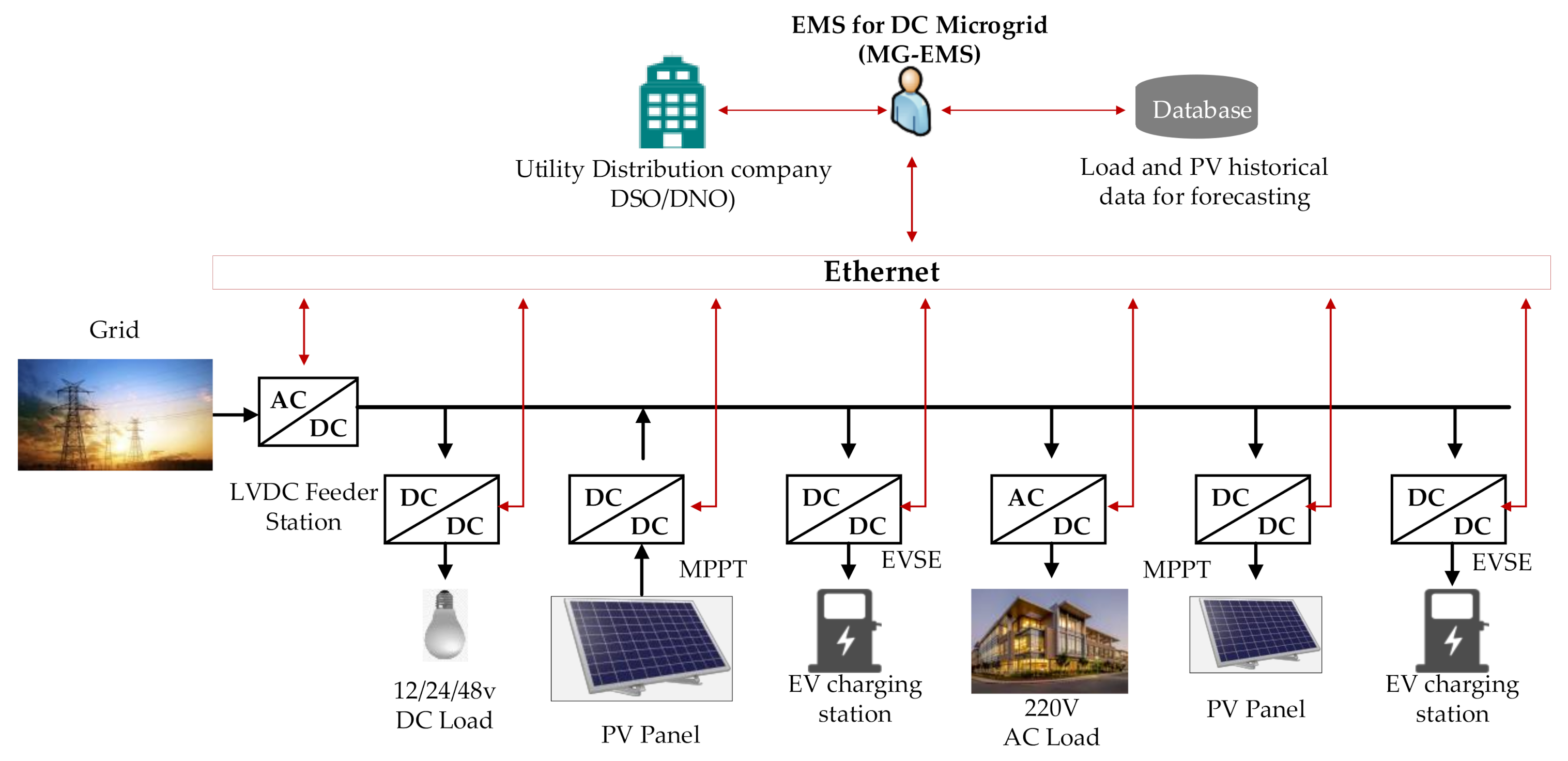
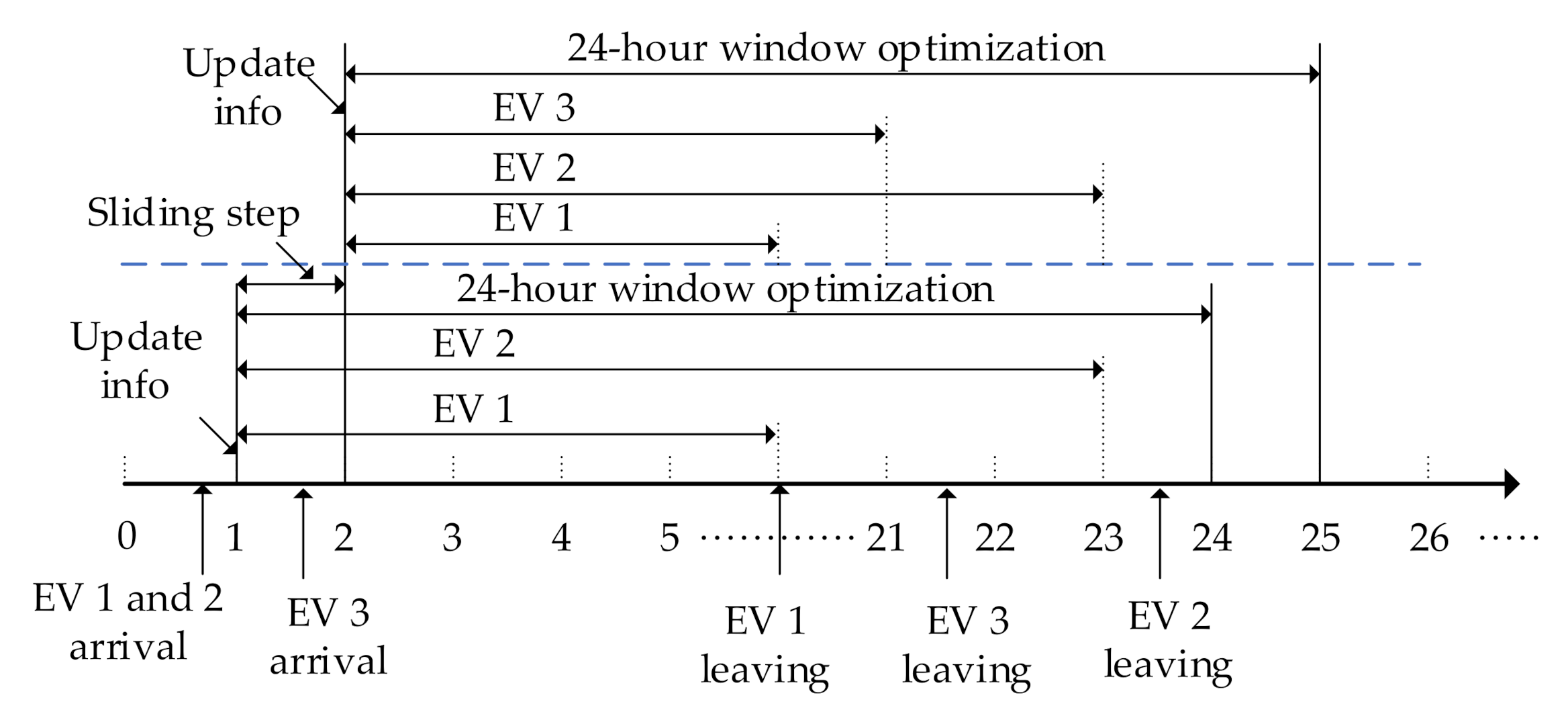
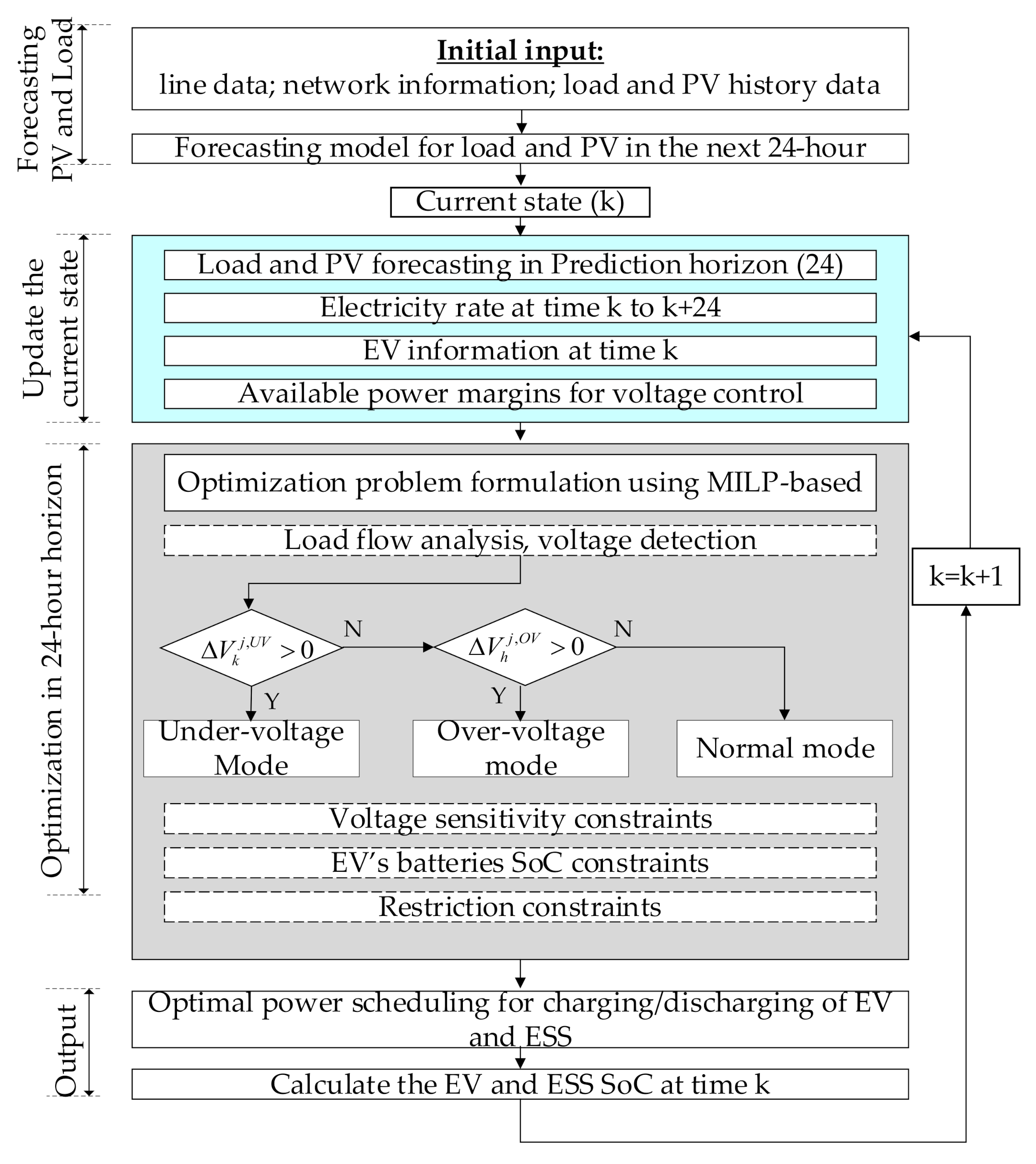

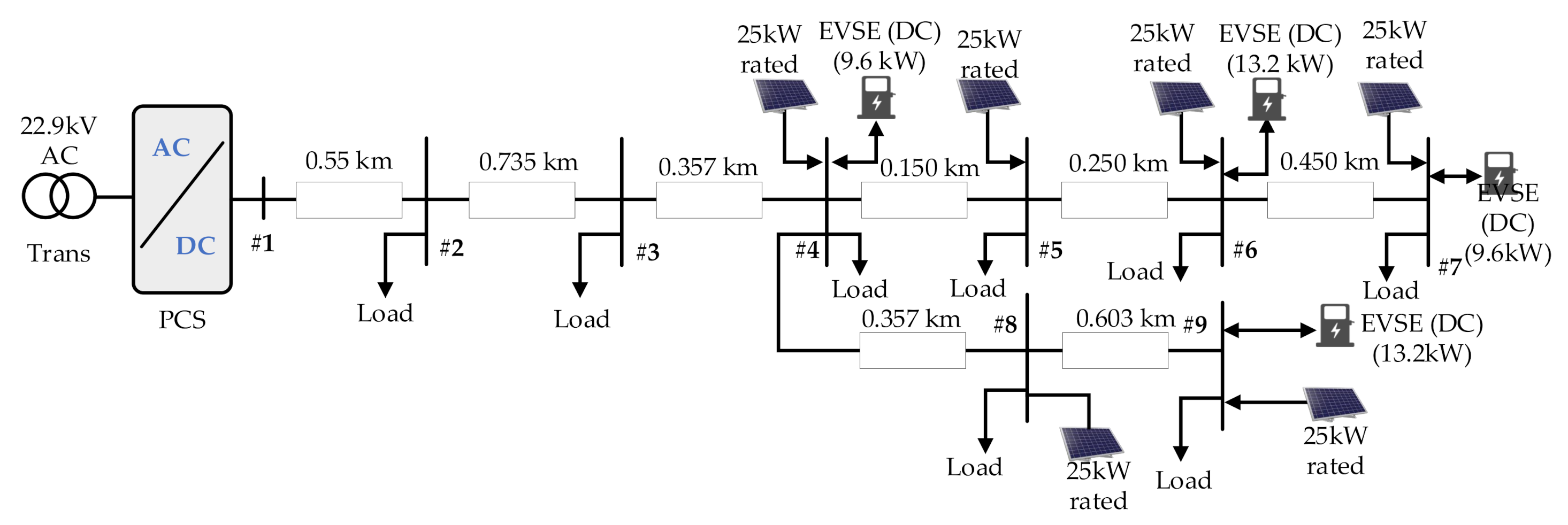
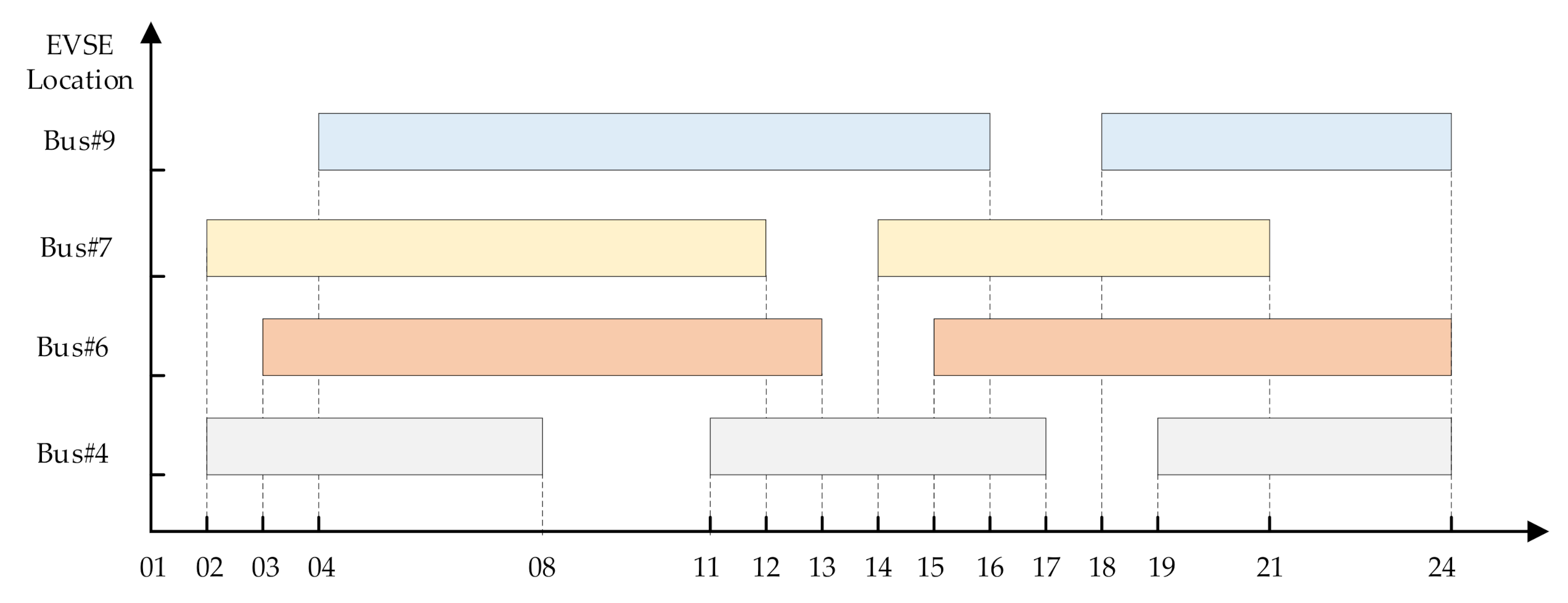

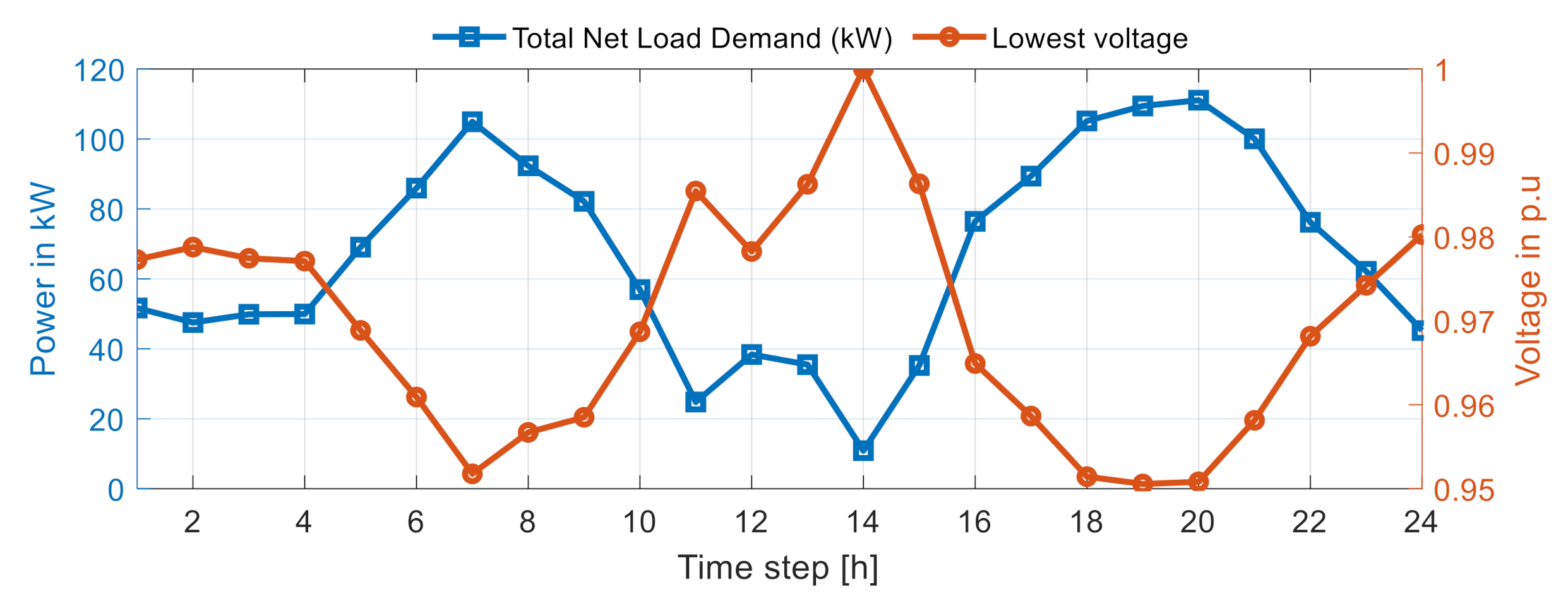
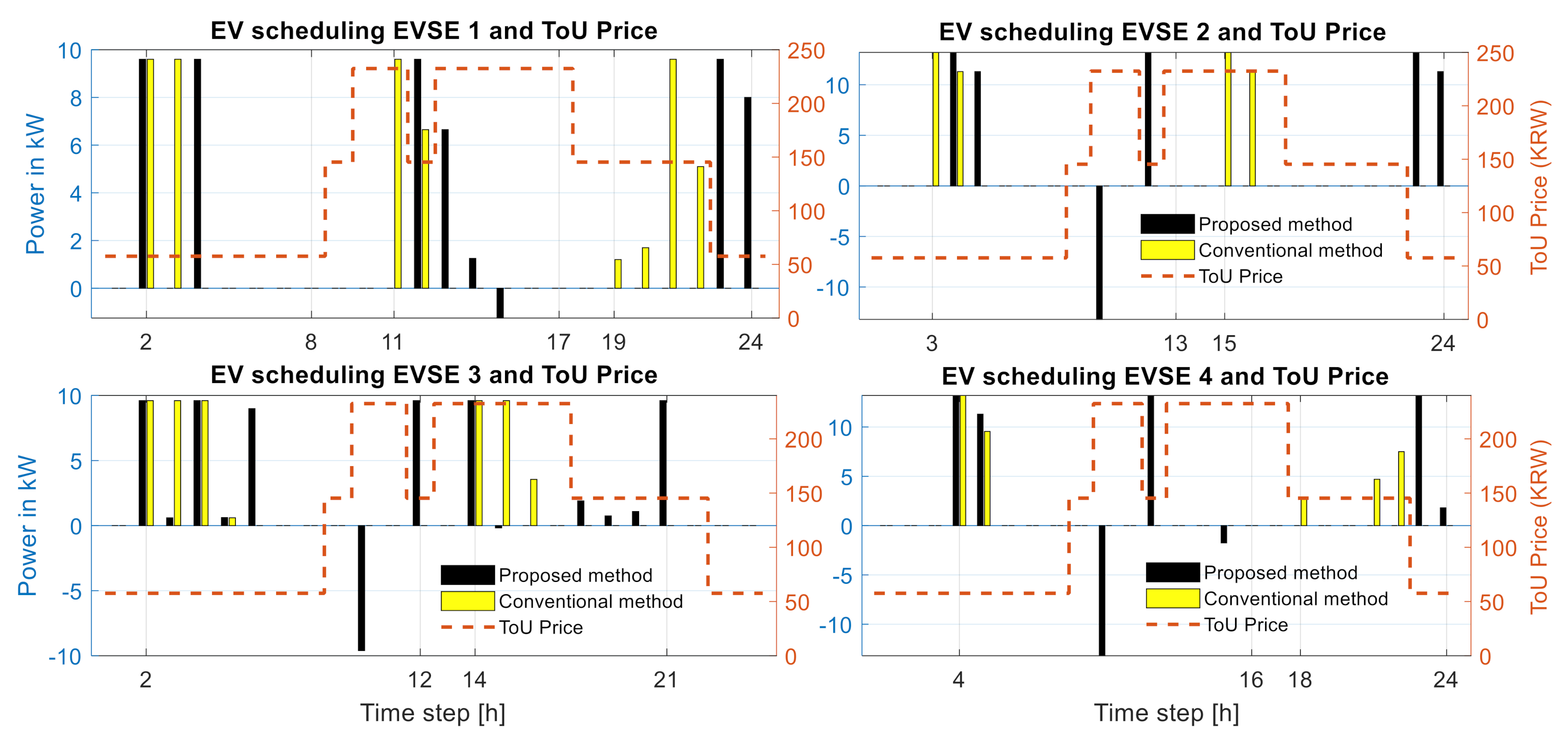
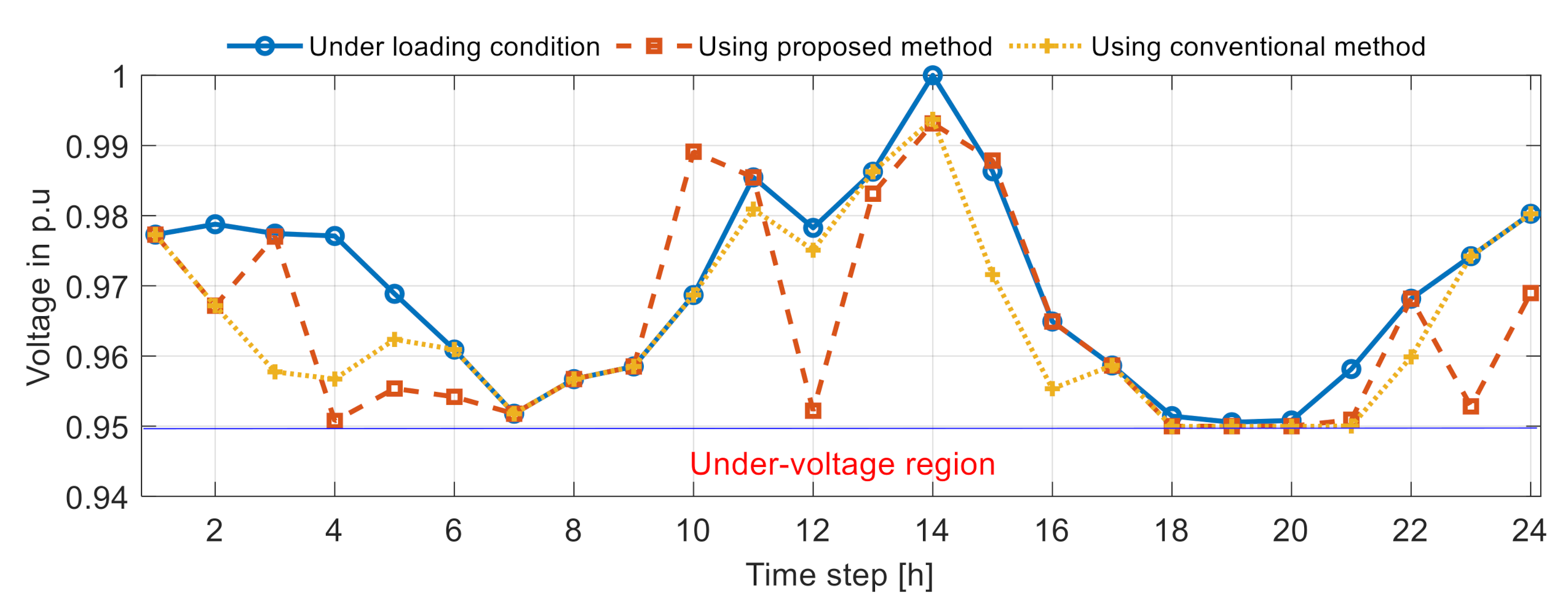
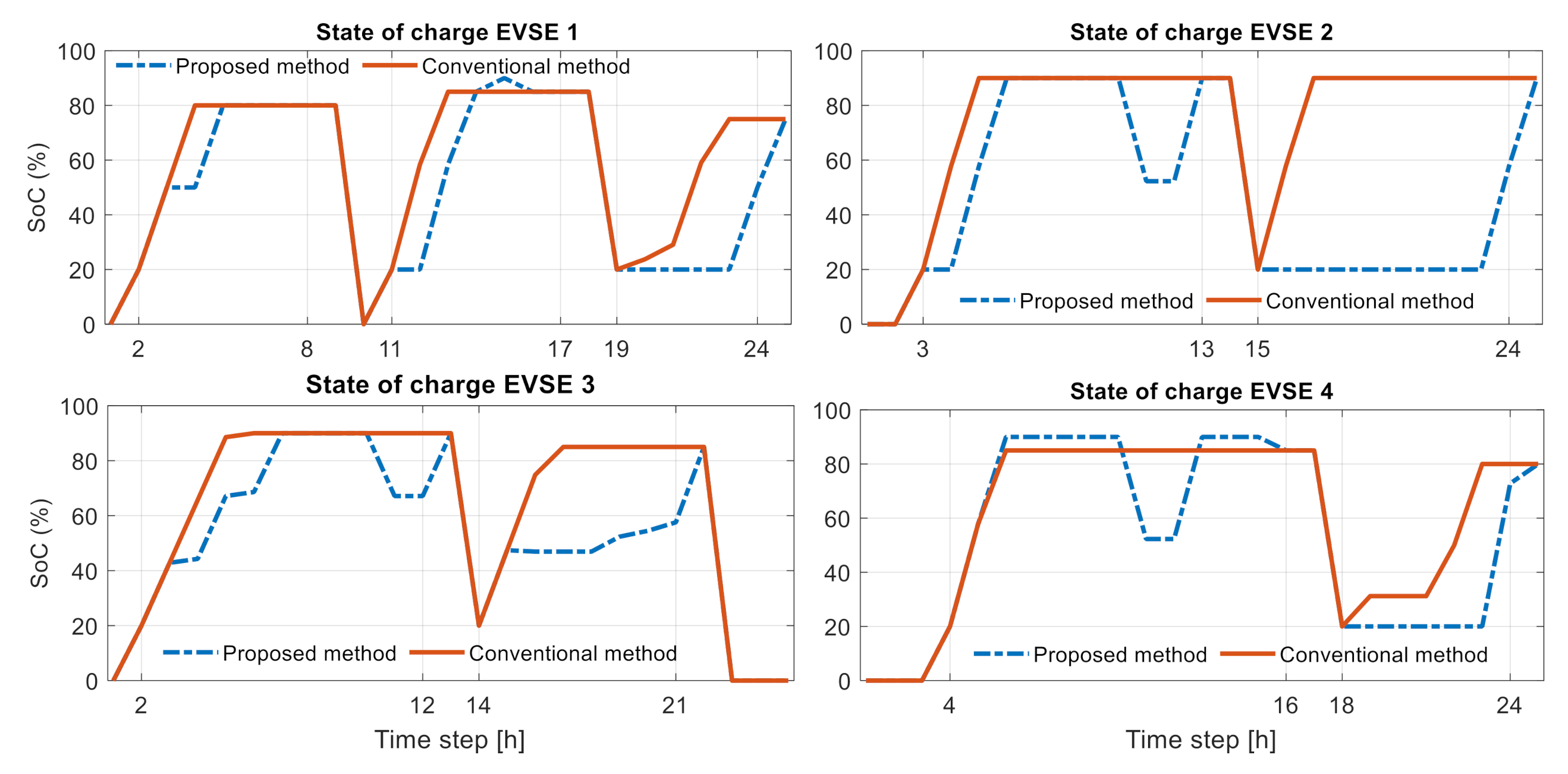

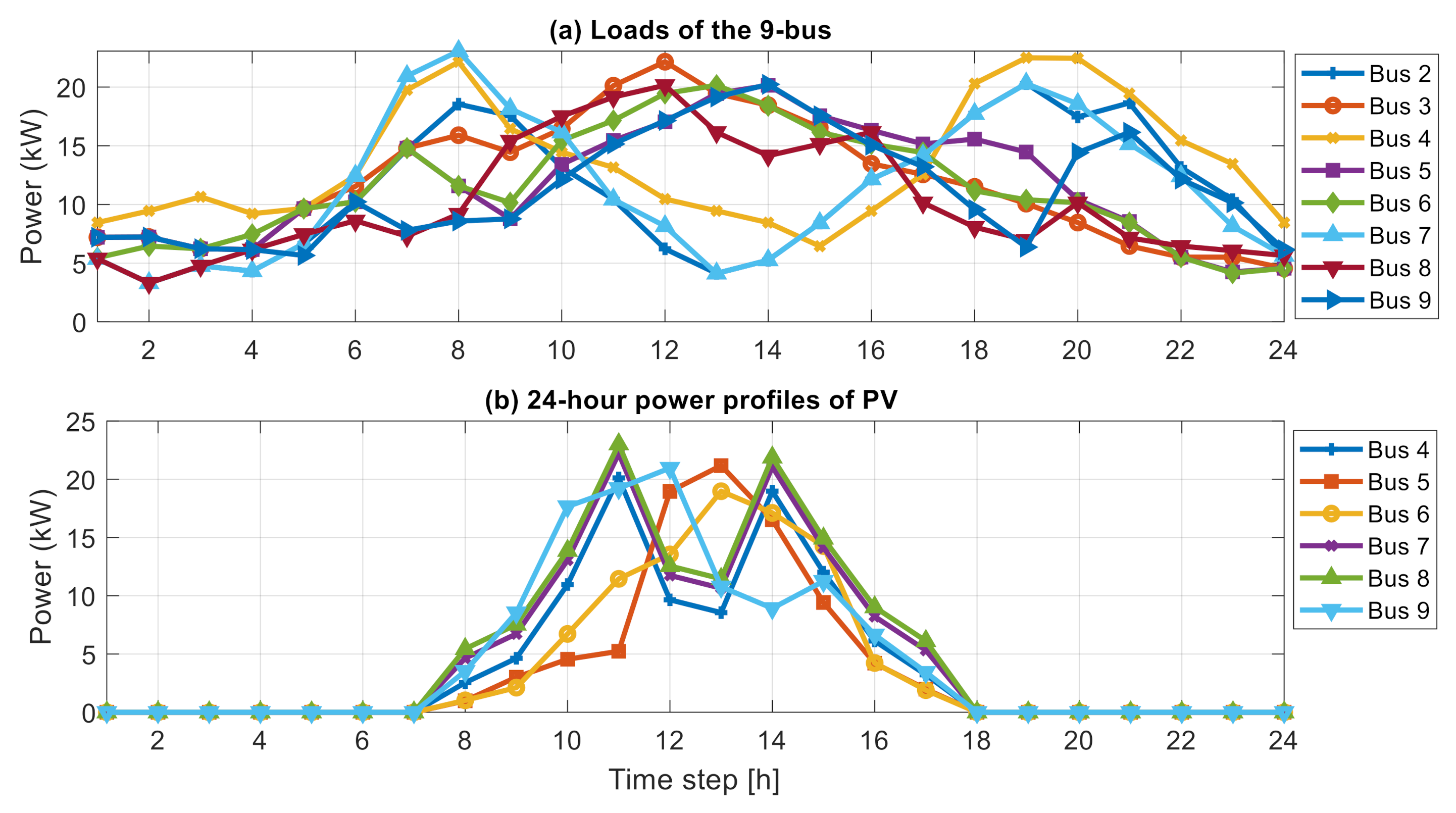
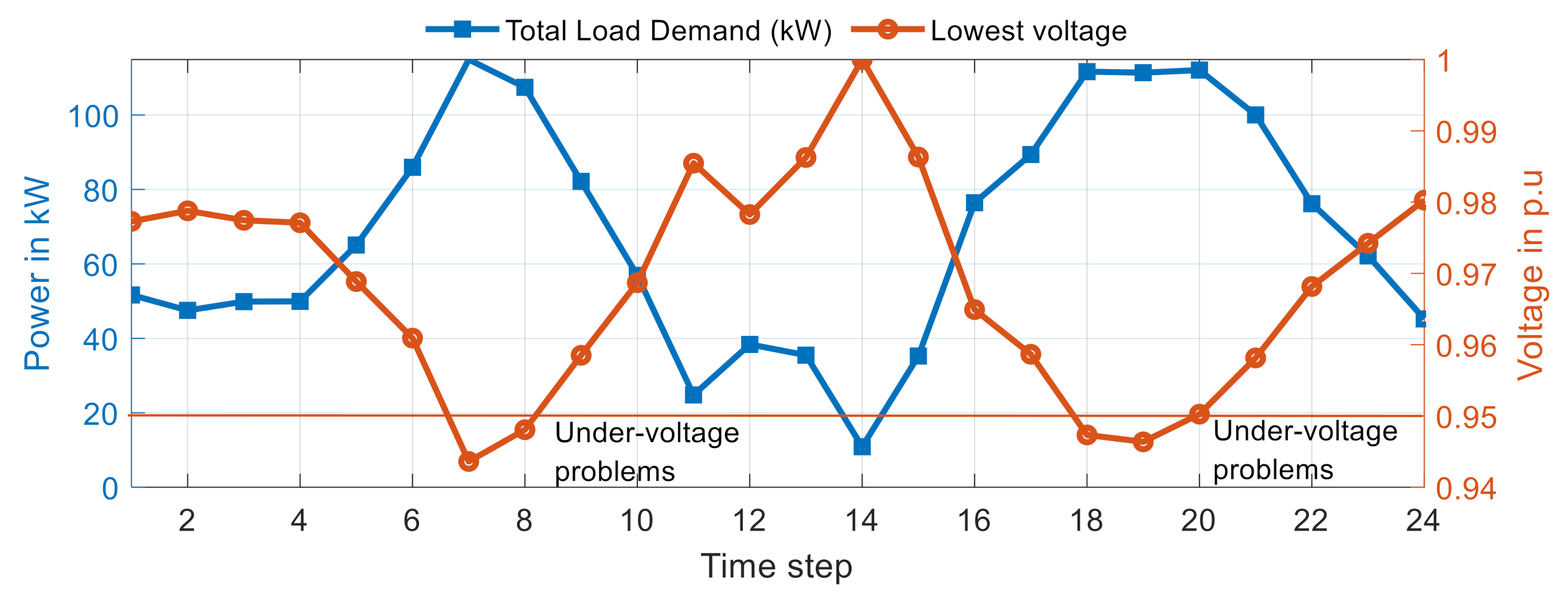

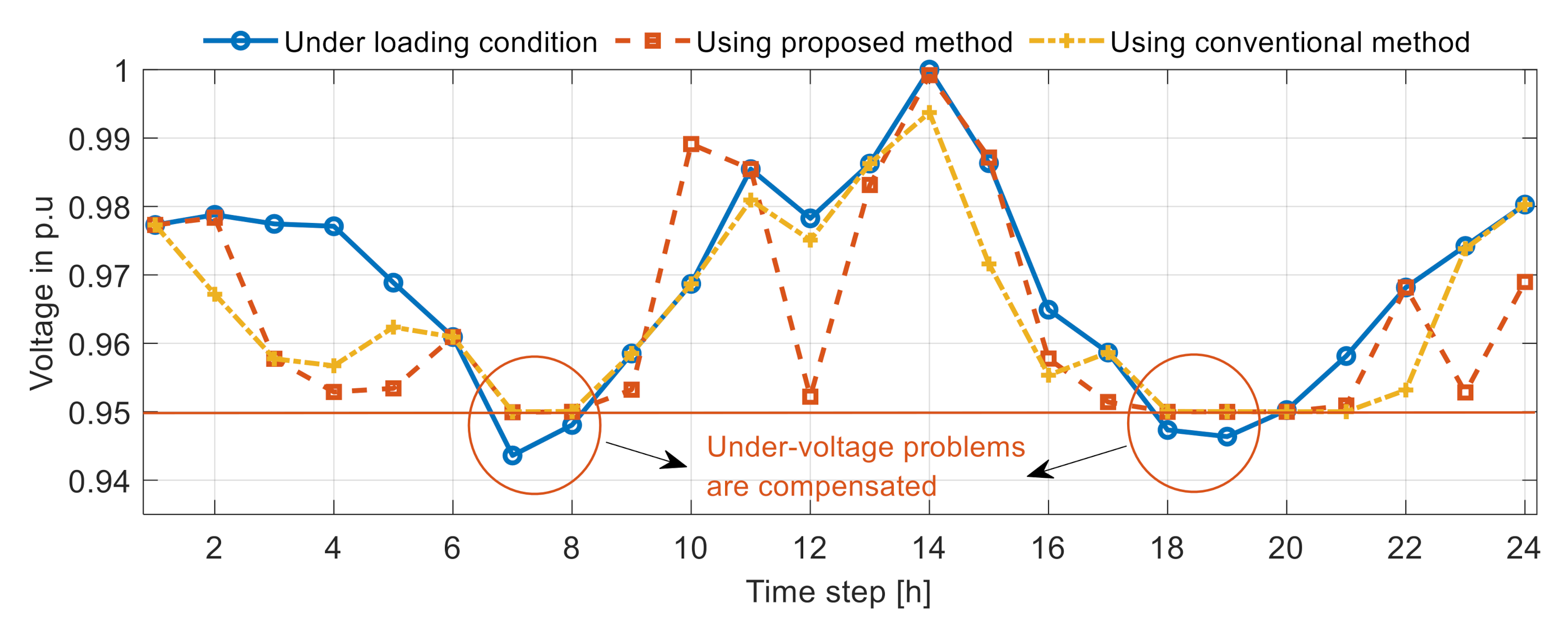
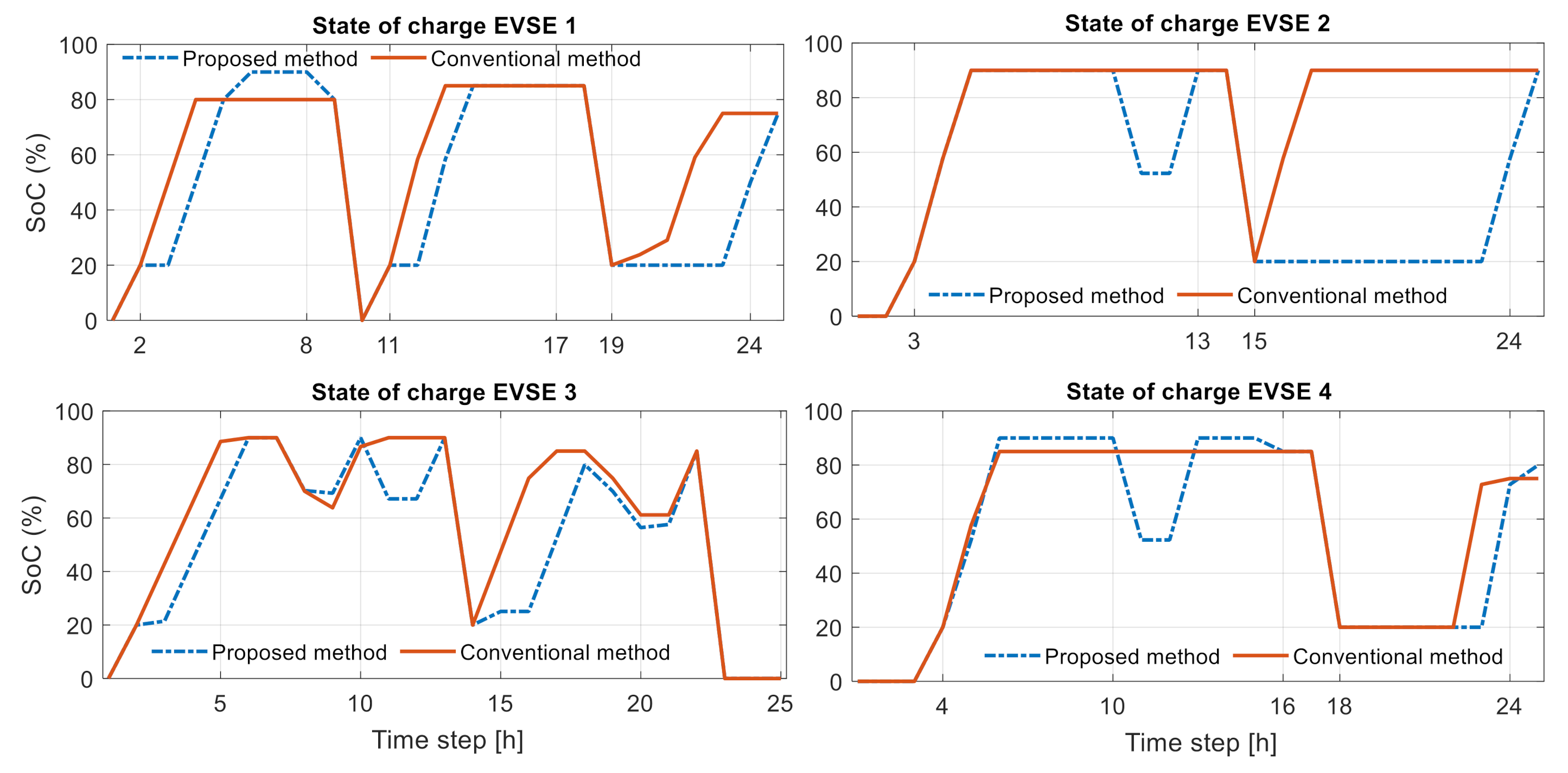

| EV Number | EVSE Location | Arrival Time | Departure Time | EV Capacity (kWh) | Initial SoC (%) | Departure SoC (%) |
|---|---|---|---|---|---|---|
| 1 | #4 | 02 AM | 08 AM | 32 | 20 | 80 |
| 2 | #7 | 02 AM | 12 PM | 35 | 20 | 90 |
| 3 | #6 | 03 AM | 13 PM | 42 | 20 | 90 |
| 4 | #9 | 04 AM | 16 PM | 35 | 20 | 85 |
| 5 | #4 | 11 AM | 17 PM | 25 | 20 | 85 |
| 6 | #7 | 14 PM | 21 PM | 35 | 20 | 85 |
| 7 | #6 | 15 PM | 24 AM | 35 | 20 | 90 |
| 8 | #9 | 18 PM | 24 AM | 25 | 20 | 80 |
| 9 | #4 | 19 PM | 24 AM | 32 | 20 | 75 |
| Energy Charge (KRW/kWh) (*) | |||
|---|---|---|---|
| Time period | Summer | Spring/Fall | Winter |
| Off-peak | 57.6 | 58.7 | 80.7 |
| Mid-peak | 145.3 | 70.5 | 128.2 |
| On-peak | 232.5 | 75.4 | 190.8 |
| Classification | Spring, Summer, and Fall (*) | Winter (*) |
|---|---|---|
| Off-peak | 23:00–09:00 | 23:00–09:00 |
| Mid-peak | 09:00–10:00 12:00–13:00 17:00–23:00 | 09:00–10:00 12:00–17:00 20:00–22:00 |
| On-peak | 10:00–12:00 13:00–17:00 | 10:00–12:00 17:00–20:00 22:00–23:00 |
| Time Step (h) | Lowest Voltage Under Load (p.u.) | Proposed Optimization Method | Conventional Method | ||||||||
|---|---|---|---|---|---|---|---|---|---|---|---|
| V (p.u.) | EVSE1 (kW) | EVSE2 (kW) | EVSE3 (kW) | EVSE4 (kW) | V (p.u.) | EVSE1 (kW) | EVSE2 (kW) | EVSE3 (kW) | EVSE4 (kW) | ||
| 1 | 0.9773 | 0.9773 | 0.00 | 0.00 | 0.00 | 0.00 | 0.9773 | 0.00 | 0.00 | 0.00 | 0.00 |
| 2 | 0.9788 | 0.9672 | 9.60 | 0.00 | 9.60 | 0.00 | 0.9672 | 9.60 | 0.00 | 9.60 | 0.00 |
| 3 | 0.9775 | 0.9770 | 0.00 | 0.00 | 0.60 | 0.00 | 0.9577 | 9.60 | 13.20 | 9.60 | 0.00 |
| 4 | 0.9771 | 0.9507 | 9.60 | 13.20 | 9.60 | 13.20 | 0.9567 | 0.00 | 11.30 | 9.60 | 13.20 |
| 5 | 0.9689 | 0.9554 | 0.00 | 11.30 | 0.61 | 11.30 | 0.9624 | 0.00 | 0.00 | 0.60 | 9.55 |
| 6 | 0.9609 | 0.9542 | 0.00 | 0.00 | 8.99 | 0.00 | 0.9609 | 0.00 | 0.00 | 0.00 | 0.00 |
| 7 | 0.9518 | 0.9518 | 0.00 | 0.00 | 0.00 | 0.00 | 0.9518 | 0.00 | 0.00 | 0.00 | 0.00 |
| 8 | 0.9567 | 0.9567 | 0.00 | 0.00 | 0.00 | 0.00 | 0.9567 | 0.00 | 0.00 | 0.00 | 0.00 |
| 9 | 0.9585 | 0.9585 | 0.00 | 0.00 | 0.00 | 0.00 | 0.9585 | 0.00 | 0.00 | 0.00 | 0.00 |
| 10 | 0.9687 | 0.9891 | 0.00 | −13.20 | −9.60 | −13.20 | 0.9687 | 0.00 | 0.00 | 0.00 | 0.00 |
| 11 | 0.9855 | 0.9855 | 0.00 | 0.00 | 0.00 | 0.00 | 0.9809 | 9.60 | 0.00 | 0.00 | 0.00 |
| 12 | 0.9783 | 0.9522 | 9.60 | 13.20 | 9.60 | 13.20 | 0.9751 | 6.65 | 0.00 | 0.00 | 0.00 |
| 13 | 0.9863 | 0.9831 | 6.65 | 0.00 | 0.00 | 0.00 | 0.9863 | 0.00 | 0.00 | 0.00 | 0.00 |
| 14 | 1.0000 | 0.9931 | 1.25 | 0.00 | 9.60 | 0.00 | 0.9937 | 0.00 | 0.00 | 9.60 | 0.00 |
| 15 | 0.9863 | 0.9879 | −1.25 | 0.00 | 0.00 | −1.75 | 0.9716 | 0.00 | 13.20 | 9.60 | 0.00 |
| 16 | 0.9649 | 0.9649 | 0.00 | 0.00 | 0.00 | 0.00 | 0.9553 | 0.00 | 11.30 | 3.55 | 0.00 |
| 17 | 0.9587 | 0.9587 | 0.00 | 0.00 | 0.00 | 0.00 | 0.9587 | 0.00 | 0.00 | 0.00 | 0.00 |
| 18 | 0.9514 | 0.9500 | 0.00 | 0.00 | 1.90 | 0.00 | 0.9500 | 0.00 | 0.00 | 0.00 | 2.80 |
| 19 | 0.9506 | 0.9500 | 0.00 | 0.00 | 0.75 | 0.00 | 0.9500 | 1.20 | 0.00 | 0.00 | 0.00 |
| 20 | 0.9508 | 0.9500 | 0.00 | 0.00 | 1.08 | 0.00 | 0.9500 | 1.70 | 0.00 | 0.00 | 0.00 |
| 21 | 0.9581 | 0.9509 | 0.00 | 0.00 | 9.60 | 0.00 | 0.9500 | 9.60 | 0.00 | 0.00 | 4.70 |
| 22 | 0.9682 | 0.9682 | 0.00 | 0.00 | 0.00 | 0.00 | 0.9599 | 5.10 | 0.00 | 0.00 | 7.50 |
| 23 | 0.9742 | 0.9528 | 9.60 | 13.20 | 0.00 | 13.20 | 0.9742 | 0.00 | 0.00 | 0.00 | 0.00 |
| 24 | 0.9803 | 0.9690 | 8.00 | 11.30 | 0.00 | 1.80 | 0.9803 | 0.00 | 0.00 | 0.00 | 0.00 |
| Time Step (h) | Lowest Voltage Under Load (p.u.) | Proposed Optimization Method | Conventional Method | ||||||||
|---|---|---|---|---|---|---|---|---|---|---|---|
| V (p.u.) | EVSE1 (kW) | EVSE2 (kW) | EVSE3 (kW) | EVSE4 (kW) | V (p.u.) | EVSE1 (kW) | EVSE2 (kW) | EVSE3 (kW) | EVSE4 (kW) | ||
| 1 | 0.9773 | 0.9773 | 0.00 | 0.00 | 0.00 | 0.00 | 0.9773 | 0.00 | 0.00 | 0.00 | 0.00 |
| 2 | 0.9788 | 0.9783 | 0.00 | 0.00 | 0.60 | 0.00 | 0.9672 | 9.60 | 0.00 | 9.60 | 0.00 |
| 3 | 0.9775 | 0.9577 | 9.60 | 13.20 | 9.60 | 0.00 | 0.9577 | 9.60 | 13.20 | 9.60 | 0.00 |
| 4 | 0.9771 | 0.9529 | 9.60 | 11.30 | 9.60 | 11.3 | 0.9567 | 0.00 | 11.30 | 9.60 | 13.2 |
| 5 | 0.9689 | 0.9534 | 3.20 | 0.00 | 9.60 | 13.2 | 0.9624 | 0.00 | 0.00 | 0.60 | 9.55 |
| 6 | 0.9609 | 0.9609 | 0.00 | 0.00 | 0.00 | 0.00 | 0.9609 | 0.00 | 0.00 | 0.00 | 0.00 |
| 7 | 0.9436 | 0.9500 | 0.00 | 0.00 | −8.30 | 0.00 | 0.9500 | 0.00 | 0.00 | −8.40 | 0.00 |
| 8 | 0.9481 | 0.9500 | −3.20 | 0.00 | −0.41 | 0.00 | 0.9500 | 0.00 | 0.00 | −2.60 | 0.00 |
| 9 | 0.9585 | 0.9532 | 0.00 | 0.00 | 8.71 | 0.00 | 0.9585 | 0.00 | 0.00 | 0.00 | 0.00 |
| 10 | 0.9687 | 0.9891 | 0.00 | −13.20 | −9.60 | −13.2 | 0.9687 | 0.00 | 0.00 | 0.00 | 0.00 |
| 11 | 0.9855 | 0.9855 | 0.00 | 0.00 | 0.00 | 0.00 | 0.9809 | 9.60 | 0.00 | 0.00 | 0.00 |
| 12 | 0.9783 | 0.9522 | 9.60 | 13.20 | 9.60 | 13.2 | 0.9751 | 6.65 | 0.00 | 0.00 | 0.00 |
| 13 | 0.9863 | 0.9831 | 6.65 | 0.00 | 0.00 | 0.00 | 0.9863 | 0.00 | 0.00 | 0.00 | 0.00 |
| 14 | 1.0000 | 0.9992 | 0.00 | 0.00 | 1.78 | 0.00 | 0.9937 | 0.00 | 0.00 | 9.60 | 0.00 |
| 15 | 0.9863 | 0.9871 | 0.00 | 0.00 | 0.00 | −1.75 | 0.9716 | 0.00 | 13.2 | 9.60 | 0.00 |
| 16 | 0.9649 | 0.9578 | 0.00 | 0.00 | 9.60 | 0.00 | 0.9553 | 0.00 | 11.3 | 3.55 | 0.00 |
| 17 | 0.9587 | 0.9514 | 0.00 | 0.00 | 9.60 | 0.00 | 0.9587 | 0.00 | 0.00 | 0.00 | 0.00 |
| 18 | 0.9473 | 0.9500 | 0.00 | 0.00 | −3.49 | 0.00 | 0.9500 | 0.00 | 0.00 | −3.55 | 0.00 |
| 19 | 0.9464 | 0.9500 | 0.00 | 0.00 | −4.75 | 0.00 | 0.9500 | 0.00 | 0.00 | −4.80 | 0.00 |
| 20 | 0.9503 | 0.9500 | 0.00 | 0.00 | 0.41 | 0.00 | 0.9500 | 0.50 | 0.00 | 0.00 | 0.00 |
| 21 | 0.9581 | 0.9509 | 0.00 | 0.00 | 9.60 | 0.00 | 0.9500 | 3.70 | 0.00 | 8.35 | 0.00 |
| 22 | 0.9682 | 0.9682 | 0.00 | 0.00 | 0.00 | 0.00 | 0.9532 | 9.60 | 0.00 | 0.00 | 13.20 |
| 23 | 0.9742 | 0.9528 | 9.60 | 13.2 | 0.00 | 13.2 | 0.9738 | 0.00 | 0.00 | 0.00 | 0.55 |
| 24 | 0.9803 | 0.969 | 8.00 | 11.3 | 0.00 | 1.80 | 0.9803 | 0.00 | 0.00 | 0.00 | 0.00 |
Publisher’s Note: MDPI stays neutral with regard to jurisdictional claims in published maps and institutional affiliations. |
© 2021 by the authors. Licensee MDPI, Basel, Switzerland. This article is an open access article distributed under the terms and conditions of the Creative Commons Attribution (CC BY) license (http://creativecommons.org/licenses/by/4.0/).
Share and Cite
Trinh, P.-H.; Chung, I.-Y. Optimal Control Strategy for Distributed Energy Resources in a DC Microgrid for Energy Cost Reduction and Voltage Regulation. Energies 2021, 14, 992. https://doi.org/10.3390/en14040992
Trinh P-H, Chung I-Y. Optimal Control Strategy for Distributed Energy Resources in a DC Microgrid for Energy Cost Reduction and Voltage Regulation. Energies. 2021; 14(4):992. https://doi.org/10.3390/en14040992
Chicago/Turabian StyleTrinh, Phi-Hai, and Il-Yop Chung. 2021. "Optimal Control Strategy for Distributed Energy Resources in a DC Microgrid for Energy Cost Reduction and Voltage Regulation" Energies 14, no. 4: 992. https://doi.org/10.3390/en14040992
APA StyleTrinh, P.-H., & Chung, I.-Y. (2021). Optimal Control Strategy for Distributed Energy Resources in a DC Microgrid for Energy Cost Reduction and Voltage Regulation. Energies, 14(4), 992. https://doi.org/10.3390/en14040992







